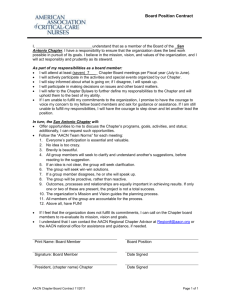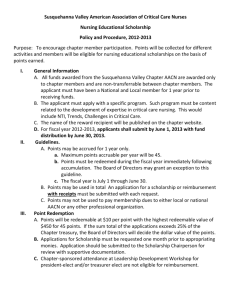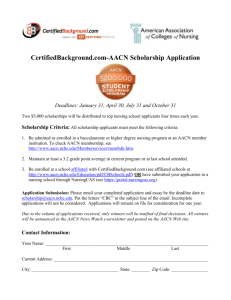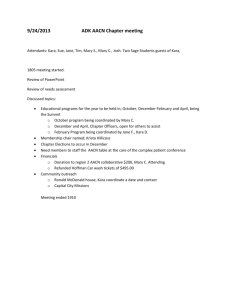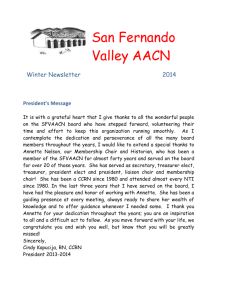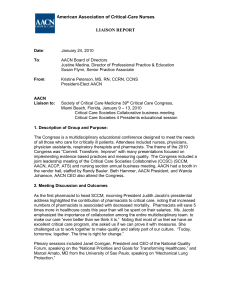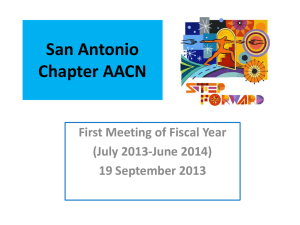AACN Liaison Framework - American Association of Critical
advertisement
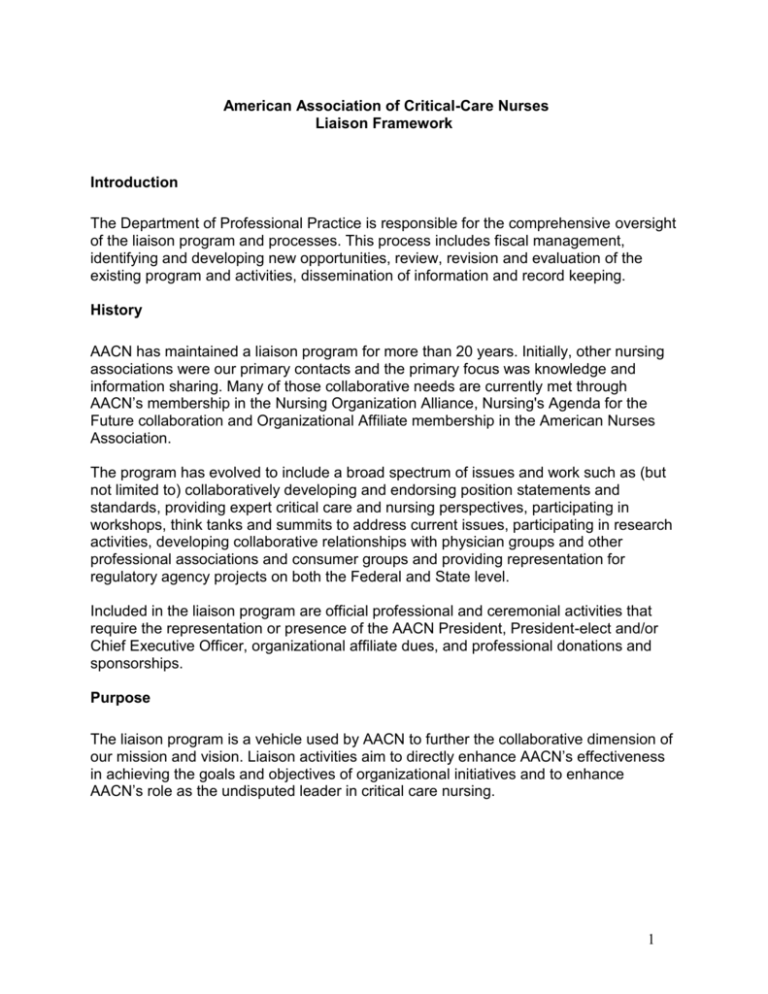
American Association of Critical-Care Nurses Liaison Framework Introduction The Department of Professional Practice is responsible for the comprehensive oversight of the liaison program and processes. This process includes fiscal management, identifying and developing new opportunities, review, revision and evaluation of the existing program and activities, dissemination of information and record keeping. History AACN has maintained a liaison program for more than 20 years. Initially, other nursing associations were our primary contacts and the primary focus was knowledge and information sharing. Many of those collaborative needs are currently met through AACN’s membership in the Nursing Organization Alliance, Nursing's Agenda for the Future collaboration and Organizational Affiliate membership in the American Nurses Association. The program has evolved to include a broad spectrum of issues and work such as (but not limited to) collaboratively developing and endorsing position statements and standards, providing expert critical care and nursing perspectives, participating in workshops, think tanks and summits to address current issues, participating in research activities, developing collaborative relationships with physician groups and other professional associations and consumer groups and providing representation for regulatory agency projects on both the Federal and State level. Included in the liaison program are official professional and ceremonial activities that require the representation or presence of the AACN President, President-elect and/or Chief Executive Officer, organizational affiliate dues, and professional donations and sponsorships. Purpose The liaison program is a vehicle used by AACN to further the collaborative dimension of our mission and vision. Liaison activities aim to directly enhance AACN’s effectiveness in achieving the goals and objectives of organizational initiatives and to enhance AACN’s role as the undisputed leader in critical care nursing. 1 Goals AACN’s operational plan drives the formation of the liaison program each year with a long-term goal of implementing strategies to boldly promote vital strategic platforms and issues to influence critical care nursing, the environments in which it is practiced and the care of patients and families. The objectives or desired outcomes of the program are to: 1. Further AACN’s mission and vision through external collaboration within the health care community. 2. Enhance AACN’s influence and professional reputation by seeking opportunities to provide leadership in activities that promote professional practice, healthy work environments and appropriate end-of-life care, address the nursing shortage and advance the health and welfare of those experiencing critical illness. 3. Advance the profession of nursing and critical care through information sharing and participation in standard setting activities. 4. Extend AACN resources to a wider audience within the professional community by providing expert critical care representation and consultation. 5. Enhance AACN’s public policy advocacy efforts through participation in legislative and regulatory activities at the federal, state and local levels. Criteria for Activity Selection Liaison opportunities vary in scope of organizational participation and cost to the organization. Cost /benefit consideration is included in the selection process. The activity should meet one or more of the following criteria: The activity(s) to be supported is related to the strategic/operational plan goals and objectives to further AACN’s mission and vision. The activity(s) is related to current issues that enhance the profession and/or advance critical care nursing. The activity(s) provides an opportunity for learning and collaborative exchange to explore strategies and solutions to critical professional and healthcare issues. The public position and reputation of the requesting organization(s) is compatible with AACN, its members and the long-term interests of the professional community. The activity(s) is cost- effective in relation to the current strategic/operational plan, goals and budget. 2 Criteria for Representative Selection Identification of potential liaisons is based on the activity objectives, scope of work and expertise required and includes seeking recommendations from the AACN BOD, staff, volunteers and other appropriate professional sources. The liaison must: Demonstrate commitment to and understanding of AACN’s mission and vision. Be a current AACN member with demonstrated expertise or influence in the particular area required by the activity. Liaison Roles AACN Liaisons function in a variety of ways. There are three typical roles a liaison may perform. Liaisons may be asked to: 1. Serve as a primary information resource to AACN about the designated group or activity. Responsibilities include: a) Attending meetings to monitor and obtain information about the activity. b) Communicating relevant information to AACN in a timely manner. c) Identifying key questions or implications for AACN. 2. Participate in the activity on behalf of AACN. Responsibilities include: a) Attending meetings and providing expert critical care representation, pertinent AACN history and resources as they relate to the group’s agenda. b) Accurately communicating AACN’s agenda, serving as a bridge between AACN and the group. c) Reporting on the activity’s progress, outcomes and implications for AACN in a timely manner. 3. Officially represent AACN to the designated group, with authority to speak on the Association’s behalf. Responsibilities include: a) Attending meetings and articulating AACN’s positions. b) Responding to the group’s initiatives. c) Making decisions related to AACN’s involvement and commitment to the group’s agenda. d) Reporting on the activity’s progress, outcomes and implications for AACN in a timely manner. 3 Process Liaison activities are initiated by external invitations and requests or internally by opportunities pursued by AACN. 1. When a liaison opportunity is identified the opportunity is evaluated internally by AACN staff using the stated criteria to determine whether to support or participate in the activity. A recommendation is then forwarded for review to the Chief Executive Officer. 2. Major new activities initiated by AACN or involving expenses not budgeted for are subject to Executive and Board of Director (BOD) approval. 3. If a positive determination is made, the liaison role and activity are clarified and an appropriate AACN liaison is identified and asked to participate on behalf of AACN. 4. Liaisons receive an official letter of appointment from the President if the position is to take effect during the fiscal year or from the President-elect for the upcoming fiscal year. 5. Liaisons serve for an appropriate period of time, depending on the outcome of the activity and the role of the liaison. 6. Liaisons are reimbursed for expenses incurred during the liaison activity according to the AACN Expense Reimbursement Policy. 7. Liaisons are required to submit a written report on the activity including outcomes and implications for AACN within 3 weeks. 8. Liaison activity updates are reported to the BOD quarterly. 9. All liaison activities are reviewed at the end of the fiscal year and the next year’s budget is projected based on ongoing activities, future anticipated activities, dues and donations. Approved November 2000 Revised July 2001 Revised June 2003 Revised June 2007 4
